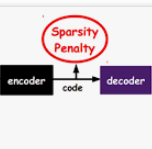Extraction of low-dimensional latent space from high-dimensional observation data is essential to construct a real-time robot controller with a world model on the extracted latent space. However, there is no established method for tuning the dimension size of the latent space automatically, suffering from finding the necessary and sufficient dimension size, i.e. the minimal realization of the world model. In this study, we analyze and improve Tsallis-based variational autoencoder (q-VAE), and reveal that, under an appropriate configuration, it always facilitates making the latent space sparse. Even if the dimension size of the pre-specified latent space is redundant compared to the minimal realization, this sparsification collapses unnecessary dimensions, allowing for easy removal of them. We experimentally verified the benefits of the sparsification by the proposed method that it can easily find the necessary and sufficient six dimensions for a reaching task with a mobile manipulator that requires a six-dimensional state space. Moreover, by planning with such a minimal-realization world model learned in the extracted dimensions, the proposed method was able to exert a more optimal action sequence in real-time, reducing the reaching accomplishment time by around 20 %. The attached video is uploaded on youtube: https://youtu.be/-QjITrnxaRs
翻译:从高维观测数据中提取低维潜层空间对于构建实时机器人控制器,在提取的潜伏空间上建立世界模型至关重要,然而,没有既定的方法可以自动调整潜伏空间的尺寸,因为要找到必要和足够的尺寸,也就是世界模型的最小化。在本研究中,我们分析并改进了基于Tsallis的基于Tsallis的变异自动coder(q-VAE),并揭示,在适当的配置下,它总是有利于使潜伏空间变得稀疏。即使与最小的实现相比,预设的潜在空间的尺寸是多余的,但这种回波化却没有必要的尺寸,使得可以轻松地去除这些空间。我们实验性地核实了潜伏空间的尺寸的好处,根据拟议的方法,它可以很容易地找到一个需要六维状态空间的流动操纵器(q-VaE)完成的任务所需的和足够的六个维度。此外,通过与在提取的维度中学习到的这种最低实现世界模型进行规划,拟议的方法能够在实时进行更优化的动作序列,在20/Rbe上缩小完成时间。




